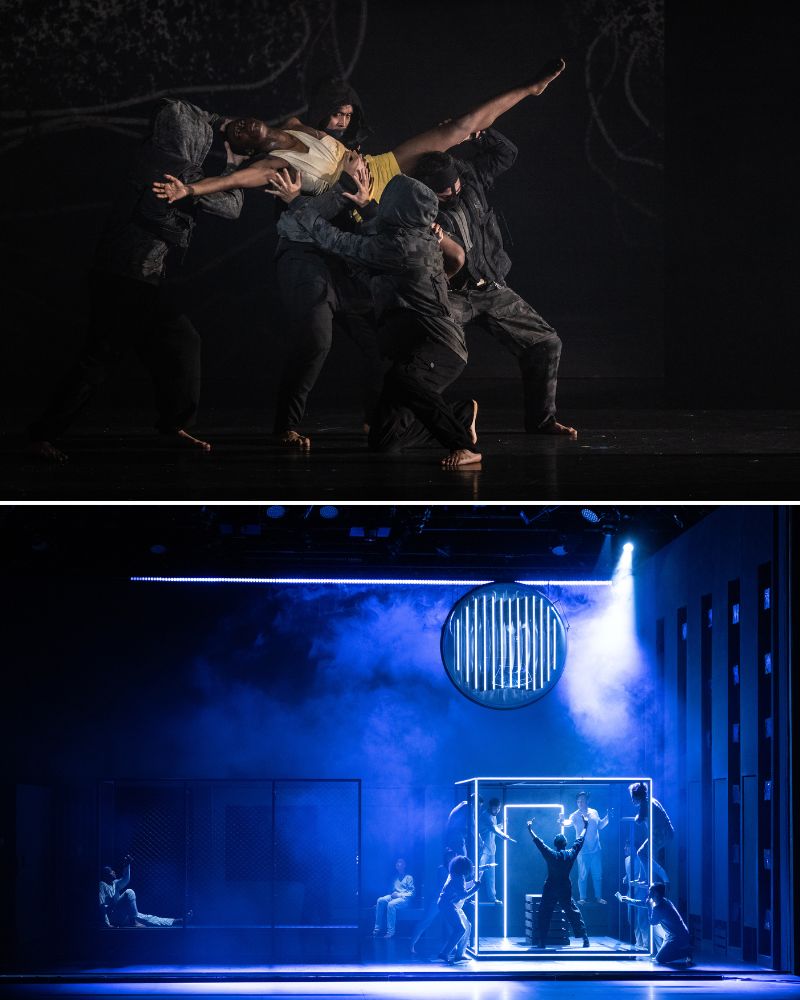Sting is in the Kennedy Center Opera House this month. Not physically — although the pre-show reminder to turn off the cell phones and devices is his unmistakable voice. The singer/composer/British pop icon’s songbook — and his ethos — serve as the foundation for Message in a Bottle, a feel-good, evening-length portrait of one family’s journey from simple pleasures to dispersion and loss to rebuilding their lives in a diaspora.
British choreographer-director Kate Prince and her company called ZooNation created Message for London’s renowned Sadler’s Wells organization, where her company is in residence. It was broadcast on PBS last year — but, as with most dance on TV or film, there’s nothing better than experiencing the performance live in the moment — feeling the kinesthesia of peak-performance-primed bodies in motion, fully committed to the movement, the story, and the message.

Message is far from a Broadway-style jukebox musical. The dialogue-less drama follows a generic Tolstoyian happy family — mother, father, and three children in a nameless village from a nameless nation. Their lives are bucolic, warm, perfect. Accompanying their joy, Sting’s “Desert Rose” sings “I dream of love as time runs through my hand.” Above, a large sun-like disk is filled with sand, raining down like an hourglass. This nuclear family with three teenage children — Leto, Mati, and Tana, according to the program — is idyllic, expressing their unity with a gestural sign language that speaks of their love and values to “If I Ever Lose My Faith in You.” The oldest son finds his love, inspired by the lyrics from “Every Little Thing She Does Is Magic,” and everyone is happy.
Until they aren’t. The larger world intrudes, in the guise of a war resulting in the death of the mother and the dispersion of the siblings. Set designer Ben Stones’ environment is spare solid walls on three sides of the stage and portable boxes, cages, and other accoutrements that shift as the journey evolves. A video backdrop by Andrzej Goulding that takes us from day to night, from desert to ocean, to city streets, to encampments, feels suggestively imagistic rather than literal — filled with starry nights and foreboding urban corners, prison bars, and by Act Two new landscapes for new experiences. Anna Fleischle’s Boho-chic costumes build on simple components and colors that can change on stage as necessary following the landscape of the story. Natasha Chivers’ lighting design serves as an integral demarcator throughout, enhancing the story with mood-shifting color saturation, while sound designer David McEwan’s industrial and natural sounds interspersed with Sting’s score are integral to the arc of the evening’s journey.
While the performers remain wordless, Sting’s 20 recorded songs become the libretto, with dramaturgy by Lolita Chakrabarti, as well as the score. For Sting fans — and novices alike — aside from the title track “Message in a Bottle,” hits like “Every Little Thing She Does Is Magic,” “Don’t Stand So Close to Me,” “Roxanne,” “Walking on the Moon,” “Every Breath You Take,” and “Spirits of the Material World” will bring you back to his Police days of the late 20th century when those songs reigned in dance clubs and on radio. Less well-known — at least for me — “Love Is the Seventh Wave,” “Englishman in New York,” and “The Bed’s Too Big Without You” — flesh out the story.

Prince’s tour-de-force dancers are as adept in lyrical, balletic pirouettes and pas de deux as they are in urban dance genres like top rock, breaking, floor work, and other forms that fall under the generic hip-hop category. Thus, the centerpiece of Message, of course, is the unforgettable dancing. A 21st-century choreographer, Prince melds genres infusing her movement language with a multilingual diversity that elevates both street and urban forms with high-level contemporary concert dance. The company of 21 dancers attacks the demanding choreography with ease and precision and undeniable forcefulness. Complex and fast-paced mimetic-like gestures become seamless conversations. The chaos of hurling bodies and masses of people illustrate battles in a civil war. An undulating clump of dancers rocking in sea-like waves becomes human cargo on a refugee boat. Regimented, militaristic rows and columns of masked dancers illustrate capture and incarceration, while women displaying their bodies in suggestive poses beneath red lights tell the story of forced prostitution.
While there are frequent requirements for synchronization and precision, this is not a cookie-cutter company of corps de ballet uniformity; each dancer is allowed — demanded, even — to put their whole being, personality, emotions, and context into their performance. The result is a living, breathing portrait of humanity, and the underlying message this approach relays: We are all individuals … but we are in this together.
Prince’s choreography captures and celebrates the toll and toil of the human story of the dispersion and migration with vivid, beautifully fleshed-out movement in partnership with Sting’s socio-political, message-driven music. A hitmaker, Sting’s music, like the title track, is undeniably message-driven. Message in a Bottle gives voice and meaning to the millions of small individual stories that contribute to our globalized story: Our lives are interconnected, whether we realize it or not. Chakrabarti, the dramaturg, noted in the program: “In 2022, statistics show that over 100 million people around the globe had been forced from their homes. More than 32 million of those people are refugees.” At the dawn of this new millennium, Sting’s message elevates the human story above the politics of nations, tribes, and factions.
Running Time: Approximately one hour and 45 minutes, including one intermission.
Message in a Bottle plays through April 21, 2024, in the Opera House at the Kennedy Center for the Performing Arts, 2700 F St NW, Washington, DC. Purchase tickets ($35–$115) online, at the box office, or by calling (202) 467-4600 or toll-free at (800) 444-1324.
The program for Message in a Bottle is online here.
COVID safety: Masks are optional in all Kennedy Center spaces for visitors and staff. Read more about the Kennedy Center’s mask policy here.
Message in a Bottle
A Sadler’s Wells and Universal Music UK Production. With ZooNation: The Kate Prince Company Co-produced with Birmingham Hippodrome and The Lowry. Research and Development for the production is supported by The Movement
CREATIVES
Director and Choreographer: Kate Prince
Music and Lyrics: Sting
Music Supervisor and New Arrangements: Alex Lacamoire
Music Producer and Arranger: Martin Terefe
Set Designer: Ben Stones
Video Designer: Andrzej Goulding
Costume Designer: Anna Fleischle
Lighting Designer: Natasha Chivers
Sound Designer: David McEwan
Music Co-Producer and Mixer: Oskar Winberg
Dramaturg Lolita Chakrabarti
Associate Choreographer: Lukas McFarlane
Music Associate and Additional Arrangements: DJ Walde
Assistant Choreographers: Tommy Franzen and Lizzie Gough
DANCERS
Oliver Andrews, Nafisah Baba, Lindon Barr, Deavion Brown, David Cottle, Harrison Dowzell, Nestor Garcia Gonzalez, Natasha Gooden, Lizzie Gough, Anna Holström, Megan Ingram, Ajani Johnson-Goffe, Charlotte Lee, Daniella May, Dylan Mayoral, Lukas McFarlane, Robbie Ordona, Lara Renaud, Hannah Sandilands, Jessey Stol, Steven Thompson, Gavin Vincent, Malachi Welsh




